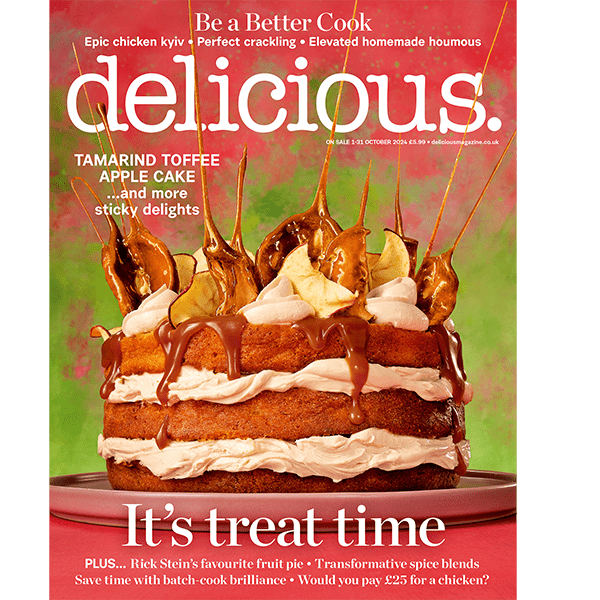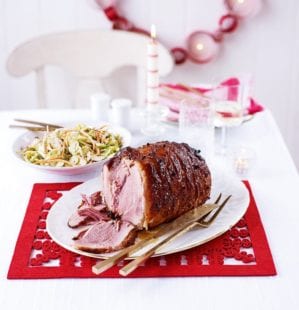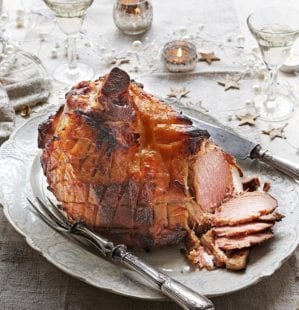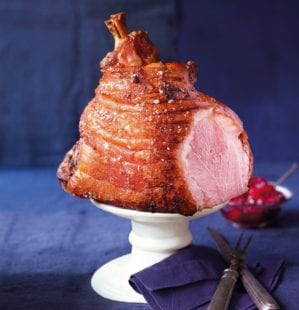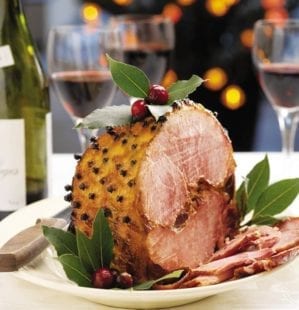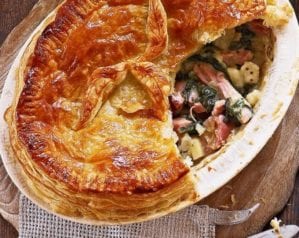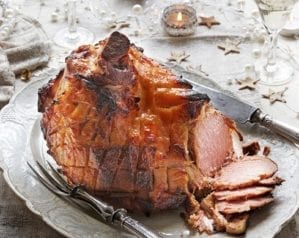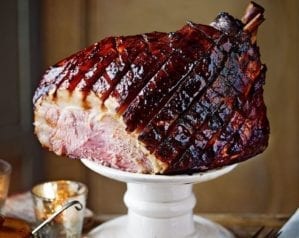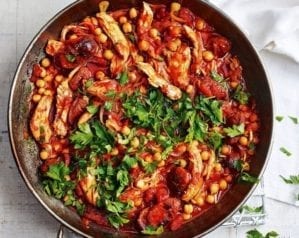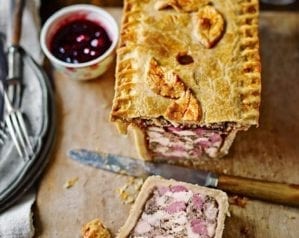
Tamarind and pomegranate caramel-glazed ham
- Published: 20 Dec 16
- Updated: 18 Mar 24
This sweet, succulent Christmas glazed ham is a feast for the eyes and the senses. Make it the centre of attention at your Boxing Day buffet.
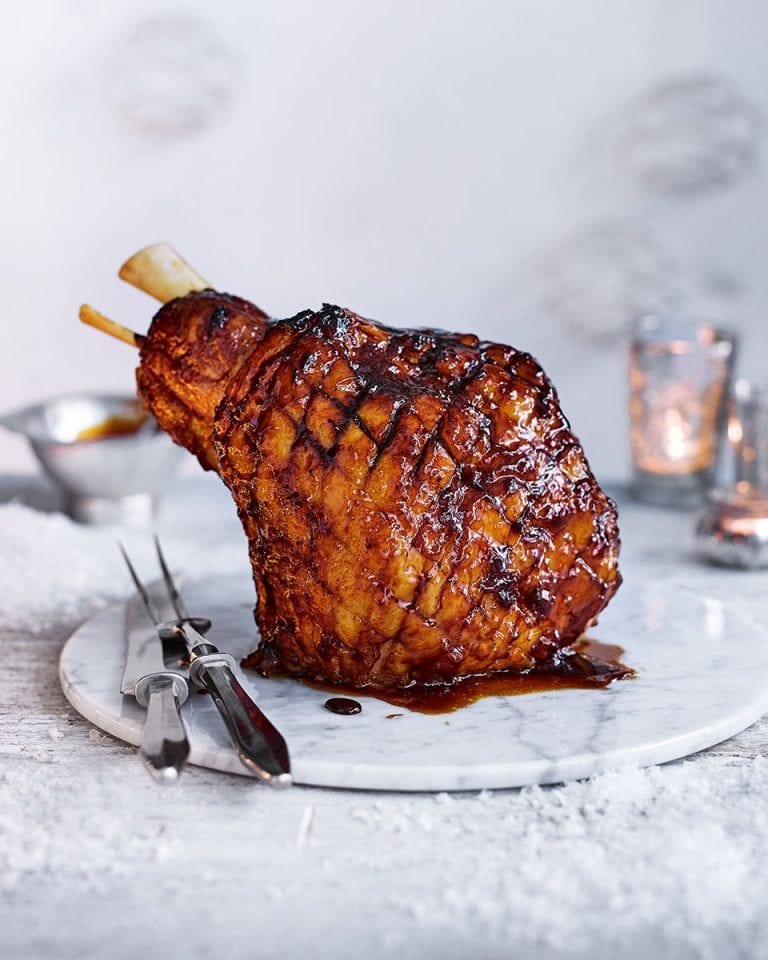
Get your mouth watering with our Christmas ham recipes. Luxurious gratin dauphinois is the perfect partner to any of them.
-
Serves 10-15 with leftovers
-
Hands-on time 30 min, simmering time 3-4 hours, oven time 25-30 min, plus cooling
Ingredients
- ½ leg (4-4.5kg) free-range, unsmoked British gammon, bone-in
- 300g caster sugar
- 5 tbsp tamarind paste
- 4 tbsp pomegranate molasses
- ¼ tsp cayenne pepper
Method
- If necessary, soak the gammon overnight in cold water. To cook, put in a very large pan that still has a bit of space to spare. Pour over cold water to cover, heat gently until simmering, then skim off any scum that forms on the surface. Simmer gently for 3-4 hours, topping up with hot water when the level drops and skimming periodically. The ham is cooked when a digital thermometer pushed into the thickest part (not touching the bone) reads 65-70°C, or the end of a skewer inserted into the thickest part for 5 seconds feels hot when pressed to the back of your wrist. Carefully remove the ham from the pan (it will be heavy!), put on a board, trying not to tear the skin, and leave to cool.
- Once cool enough to handle, slice away the skin using a sharp knife, leaving as much of the fat on the ham as possible. Pat the ham dry with kitchen paper, then score a diamond pattern into the fat. Put the ham in a shallow roasting tin lined with baking paper and heat the oven to 240°C/220°C fan/gas 9.
- To make the caramel, spread the sugar evenly over the base of a large, spotlessly clean frying pan, put it over a very low heat on the widest burner and leave it to melt and caramelise to a brick-red colour. Try not to disturb it at all, but if it begins to turn red in places before some of the sugar has melted, move the mixture around gently with a fork and leave to melt again. Once the caramel’s brick red, add the rest of the ingredients and stir. Be careful – it will bubble violently, but keep it over a low heat and it will calm down.
- Keep the caramel on the lowest heat possible and brush or spoon it thickly all over the scored fat of the ham – you’ll have some left over. Put the ham in the fridge briefly to set the caramel, then transfer to the oven and roast for 25-30 minutes, bringing it out 2-3 times to re-glaze with the caramel that will have run off and pooled at the bottom, and with any left in the pan. Once the caramel is dark golden and the fat is starting to crisp, remove the ham, glaze for a final time, leave to cool for at least 15 minutes, then slice to serve.
- Recipe from December 2016 Issue
Nutrition
Per 100g
- Calories
- 159kcals
- Fat
- 6.8g (2.3g saturated)
- Protein
- 15.8g
- Carbohydrates
- 8.7g (8.6g sugars)
- Fibre
- no fibre
- Salt
- 2g
delicious. tips
The ham we used was provided by The Ginger Pig and tunnel boned from the hock (knuckle) up. This way, you get the traditional appearance but it’s easier to carve as there’s no big, central bone. If you have an obliging butcher, ask them to do the same. It will need to be tied to keep its shape, and once boiled it should be cooled and chilled overnight before the string and skin are removed for glazing.
Ham terminology is confusing. An uncooked, cured back leg of pork is referred to as a gammon. These come green (unsmoked) or smoked. Which you choose is up to you, but smoked gammons can be a lot saltier than unsmoked, so take that into account. Here’s the confusing part: once you cook a gammon, it becomes a ham.
If you want the traditional shaped ham, order one with the bone in. The donwsides to this are that it can be more difficult to carve, and you need to be extra careful that the meat is cooked around the bone. For easy carving and less hassle, get a boned and rolled gammon.
The finished ham will keep chilled for up to a week, well covered.
You can boil the ham the day before serving, then cool, wrap in baking paper and cling film, and chill overnight. If you’re doing this, make sure it hits 70°C in step 1. The next day, bring to room temperature, remove the skin, glaze and roast. The ham won’t be hot in the middle but that’s fine – it will be crisp on the outside.
Buy ingredients online
Rate & review
Rate
Reviews
Subscribe to our magazine
Food stories, skills and tested recipes, straight to your door... Enjoy 5 issues for just £5 with our special introductory offer.
Subscribe
Unleash your inner chef
Looking for inspiration? Receive the latest recipes with our newsletter
